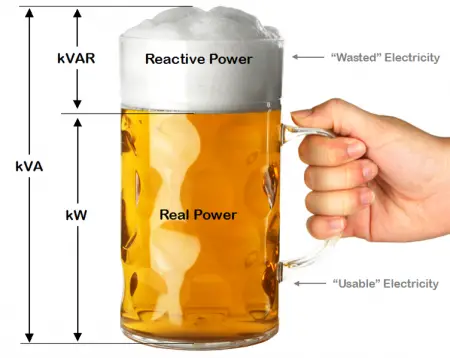Electrical energy is almost exclusively generated, transmitted, and distributed in the form of alternating currents. Therefore, the question of the power factor immediately comes into the picture. Most of the loads (e.g., induction motors, arc lamps) are inductive in nature and hence have a low lagging power factor.
The low power factor is highly undesirable as it causes an increase in current, resulting in additional losses of active power in all the elements of the power system from the power station generator down to the utilization devices. In order to ensure the most favorable conditions for a supply system from an engineering and economic point of view, it is important to have power factors as close to unity as possible.
Power Factor
Definition:- The cosine of the angle between voltage and current in an a.c. circuit is known as the power factor.
Consider an inductive circuit taking a lagging current I from supply voltage V; the angle of lag being φ. The phasor diagram of the circuit is shown in Fig. 6.1. The circuit current I can be resolved into two perpendicular components, namely;
- (a) I cos φ in phase with V
- (b) I sin φ 90o out of phase with V
The component I cos φ is known as the active or wattful component, whereas component I sin φ is called the reactive or wattless component. The reactive component is a measure of the power factor. If the reactive component is small, the phase angle φ is small and hence power factor cos φ will be high. Therefore, a circuit having a small reactive current (i.e., I sin φ) will have a high power factor and vice-versa.
It may be noted that the value of the power factor can never be more than unity.
- (i) It is a usual practice to attach the word ‘lagging’ or ‘leading’ with the numerical value of the power factor to signify whether the current lags or leads the voltage. Thus, if the circuit has a p.f. of 0·5 and the current lags the voltage, we generally write p.f. as 0·5 lagging.
- (ii) Sometimes power factor is expressed as a percentage. Thus 0·8 lagging power factor may be expressed as 80% lagging.
Beer Analogy of Power Factor
Three types of power can be represented by the beer analogy:
Power Factor Calculations:
The power factor of a circuit can be defined in one of the following three ways:
 Disadvantages of Low Power Factor
Disadvantages of Low Power Factor
The power factor plays an important role in a.c. circuits, since power consumed, depends upon this factor.
It is clear from above that for fixed power and voltage, the load current is inversely proportional to the power factor. The lower the power factor, the higher the load current and vice-versa. A power factor less than unity results in the following disadvantages:
(i) Large kVA rating of the equipment: The electrical machinery (e.g., alternators, transformers, switchgear) is always rated in *kVA.
 It is clear that the kVA rating of the equipment is inversely proportional to the power factor. The smaller the power factor, the larger the kVA rating. Therefore, at a low power factor, the kVA rating of the equipment has to be made more, making the equipment larger and more expensive.
It is clear that the kVA rating of the equipment is inversely proportional to the power factor. The smaller the power factor, the larger the kVA rating. Therefore, at a low power factor, the kVA rating of the equipment has to be made more, making the equipment larger and more expensive.
(ii) Greater conductor size: To transmit or distribute a fixed amount of power at constant voltage, the conductor will have to carry more current at a low power factor. This necessitates a large conductor size.
(iii) Large copper losses: The large current at a low power factor causes more I 2 R losses in all the elements of the supply system. This results in poor efficiency.
(iv) Poor voltage regulation: The large current at a low lagging power factor causes greater voltage drops in alternators, transformers, transmission lines, and distributors. This results in the decreased voltage available at the supply end, thus impairing the performance of utilization devices. In order to keep the receiving end voltage within permissible limits, extra equipment (i.e., voltage regulators) is required.
(v) Reduced handling capacity of the system: The lagging power factor reduces the handling capacity of all the elements of the system. It is because the reactive component of the current prevents the full utilization of installed capacity.
Causes of Low Power Factor
The low power factor is undesirable from an economic point of view. Normally, the power factor of the whole load on the supply system is lower than 0·8. The following are the causes of low power factor:
- Most of the a.c. motors are of induction type (1φ and 3φ induction motors) which have a low lagging power factor. These motors work at a power factor that is extremely small on light load (0·2 to 0·3) and rises to 0·8 or 0·9 at full load.
- Arc lamps, electric discharge lamps, and industrial heating furnaces operate at low lagging power factors.
- The load on the power system is varying; being high during morning and evening and low at other times. During the low load period, the supply voltage is increased which increases the magnetization current. This results in a decreased power factor.








